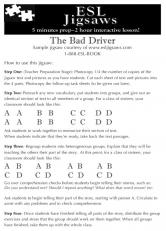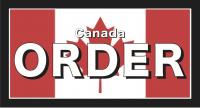ESL Jigsaws
5 Minutes Prep - 2 Hour Interactive Lesson!
How Are ESL Books Priced?
Sometimes teachers I speak to at conferences mention that all their colleagues at other schools have my books and so I must be retired now, living off the proceeds of my books. This always inspires a laugh! Other times, teachers comment on how they wonder why photocopiable books are so expensive. Surely, the author or publisher must be making a lot of money at these prices?
I can attest to the fact that there is no pot of gold at the end of the ESL textbook rainbow!
Generally speaking, regular non-photocopiable book pricing goes like this:
• Printing: 12%
• Bookstore discount: 40%
• Distributor fee: 15%-20%
• Publicity and marketing, usually at ESL conferences: 25%
So, for an ESL book priced at $20.00 retail, here's what the breakdown should be:
• Printing: $2.50
• Bookstore: $8.00
• Distributor fee: $3.00
• Publicity and marketing: $5.00
The problem with this calculation is that printing costs are only that low, if you are lucky, with very large print runs, such as 3000 copies. Selling 5000 books in Canada makes you a bestseller, but over what period of time? And how many ESL authors have best sellers? If you are a self-publisher, where do you plan to store 3000 copies of your book until they sell? Do you need to add a storage locker into the above costs?
Chances are, you cannot even afford the capital outlay for a print run of 3000, let alone the rental of a storage locker. So, with a print run of 500, for example, that printing cost of $2.50 for a $20 book just jumped to about $6.00 or $7.00 a book! Or in other words, the 12% printing cost just jumped to 30%.
I'm not sure where to list credit card fees in that calculation above or what percentage of overall costs they end up being. Most teachers don't use cash to buy books at conferences. Visa and Mastercard charge small businesses significant fees per transaction. Add to that, the banking fees when you have a business account. These charges cut into profits as well.
If your books are photocopiable, as mine are, your customers are never buying class sets. Your sales are one book at a time. Photocopiable books are normally significantly more expensive to compensate to some extent for the lost revenue when teachers photocopy books over and over again for years.
In my own case, according to the above standard formula, my books are significantly underpriced.
So many teachers have great ideas for materials for ESL classes. I'd like to encourage these aspiring writers to share their materials with the profession through self-publishing. Often teacher-made materials written by those who have been employed in the field are the most creative and useful. Just don't expect to quit your day job.
I hope this answers questions as to how ESL books are priced and assures purchasing teachers that they are getting fair value for their money and not paying for anyone's second home in the Bahamas.
Post your comment
Comments
-
How about making some pdf versions available for sale, cutting out the printing/transport etc costs?
Posted by Oliver, 07/10/2015 6:36am (4 years ago)
RSS feed for comments on this page | RSS feed for all comments


